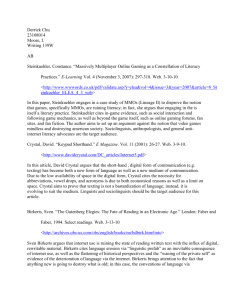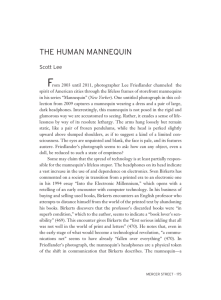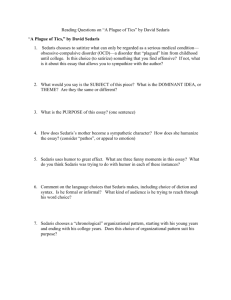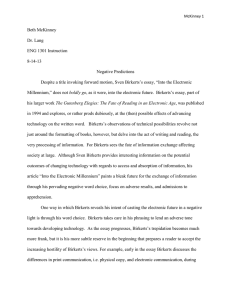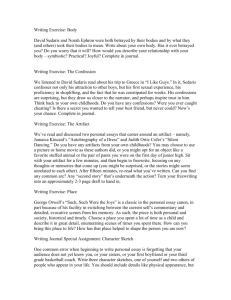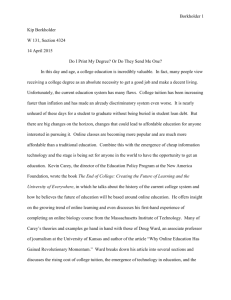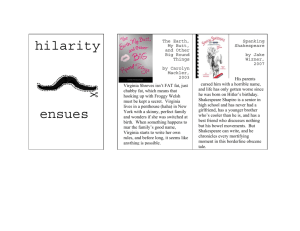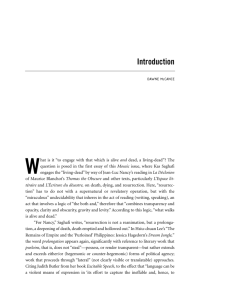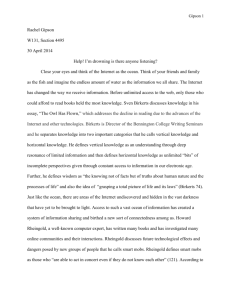Looking Past the Present - Expository Writing Program | New York
advertisement
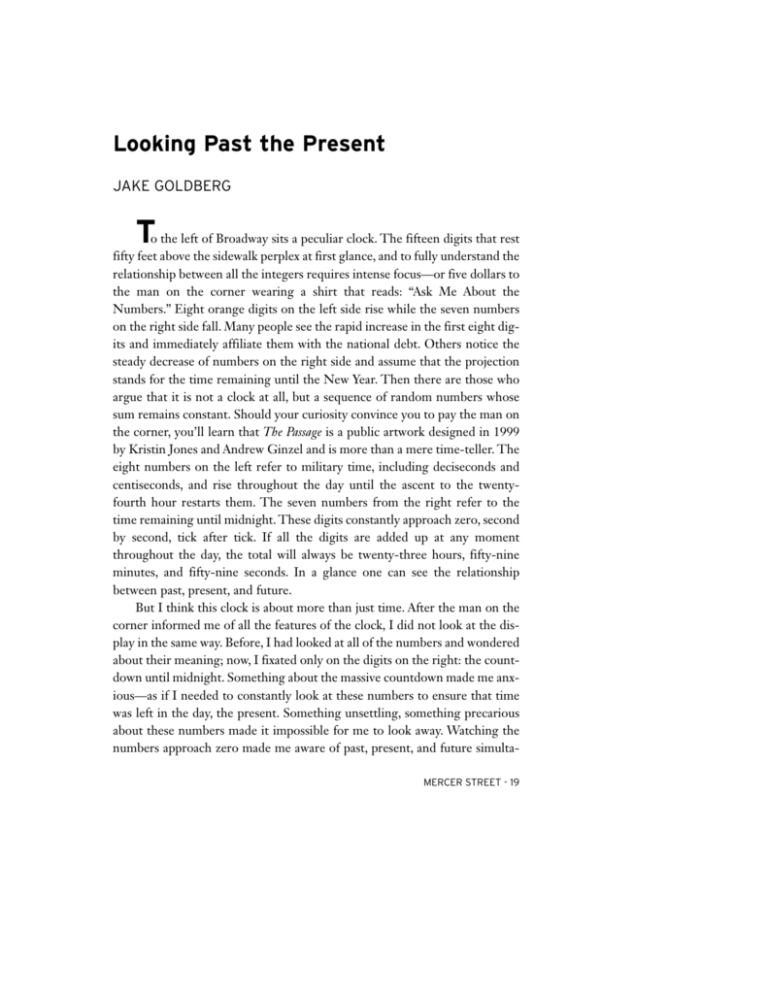
Looking Past the Present JAKE GOLDBERG T o the left of Broadway sits a peculiar clock. The fifteen digits that rest fifty feet above the sidewalk perplex at first glance, and to fully understand the relationship between all the integers requires intense focus—or five dollars to the man on the corner wearing a shirt that reads: “Ask Me About the Numbers.” Eight orange digits on the left side rise while the seven numbers on the right side fall. Many people see the rapid increase in the first eight digits and immediately affiliate them with the national debt. Others notice the steady decrease of numbers on the right side and assume that the projection stands for the time remaining until the New Year. Then there are those who argue that it is not a clock at all, but a sequence of random numbers whose sum remains constant. Should your curiosity convince you to pay the man on the corner, you’ll learn that The Passage is a public artwork designed in 1999 by Kristin Jones and Andrew Ginzel and is more than a mere time-teller. The eight numbers on the left refer to military time, including deciseconds and centiseconds, and rise throughout the day until the ascent to the twentyfourth hour restarts them. The seven numbers from the right refer to the time remaining until midnight. These digits constantly approach zero, second by second, tick after tick. If all the digits are added up at any moment throughout the day, the total will always be twenty-three hours, fifty-nine minutes, and fifty-nine seconds. In a glance one can see the relationship between past, present, and future. But I think this clock is about more than just time. After the man on the corner informed me of all the features of the clock, I did not look at the display in the same way. Before, I had looked at all of the numbers and wondered about their meaning; now, I fixated only on the digits on the right: the countdown until midnight. Something about the massive countdown made me anxious—as if I needed to constantly look at these numbers to ensure that time was left in the day, the present. Something unsettling, something precarious about these numbers made it impossible for me to look away. Watching the numbers approach zero made me aware of past, present, and future simultaMERCER STREET - 19 neously. As I stood in the blur of the present, I feared that the past was slipping away and the future was approaching too fast. I could not accept the inevitable transition to the future. I feared the passage into the unknown. Sven Birkerts’s essay “Into the Electronic Millenium” generates the same uneasiness that I felt when looking at the right side of the clock—a premonition of the end. This fear and skepticism about the future guides Birkerts through his doomsday account of the coming technological apocalypse; he examines our shift from a society centered on printed text to one focused on electronic text. As a consequence of this shift, Birkerts predicts the erosion of our language, the “flattening” of historical perspectives, and the dissipation of the “private self” (475). As we abandon printed books, Birkerts argues that our past—the pillars on which our society has been founded—will be destroyed, forgotten, sacrificed: “It was as if heading to the future also required the destruction of tokens from the past” (470). His alarming predictions stem from the idea that printed words contain subconscious “assumptions” that are vital to their significance, while electronic text does not. Birkerts emphasizes that the nature of books is to show an organized order of communication. In other words, books are created the way they are meant to be read: the reader sees the layers of earlier ideas the writer has built on. In Birkerts’s words, “The presentation [of books] structures the reception and, in time, the expectations about how information is organized” (472). Electronic text lacks this structure and the accompanying “assumptions” about layering, which, as Birkerts points out, changes our perception of history because the “natural,” materialized way that books are read is replaced by “vanishing” images on a screen. Much of Birkerts’s concern about “closed-circuit” text is based on his claim that new technology encourages a “heightened” awareness of the present, which works against a historical perception that depends on “logic and sequential succession” (472). Our subconscious mind, which perceives the history underlying books, becomes distracted by electronic text—fixing our attention on the present, abandoning our past. According to Birkerts, we no longer acknowledge the “assumptions” of books due to the influence of “closed-circuited” language. The narrowing of language—the curtailing of expression through different mediums—has become increasingly prevalent. We have seen texting, Twitter, even “Cloud” storage reduce and morph our ideas—our personal “data”—to fit an allotted amount of space. Because of this reduction, language has become increasingly symbolic. Our words are condensed to match the capacity in which they can be stored, while still representing ideas that exceed their given dimensions. But Birkerts’s concern 20 - MERCER STREET that the “electronic counterpart reduces [printed text] to a signal, a means to an end,” suggests that text on a screen is not symbolic at all, and that by deviating from printed text, our past—our “textual moorings”—will therefore be destroyed (473). But if pixels keep us stuck in the present, as Birkerts suggests, then why do I dwell on the past and the future as I gaze up at the massive orange, pixelated numbers of The Passage? Birkerts believes that the differences between printed text and electronic text originate not from the physical presentation but from what they represent—the essential perceptions of the readers. Birkerts urges his readers to believe that books represent an unchanging state in which ideas move forward while the reader remains static, allowing us to sustain our attention. Technological advances, on the other hand, are “felt to be evanescent” (472). This conception of written representation as static highlights the uniqueness of human language as a symbolic system. In her essay “Signs and Symbols,” Suzanne K. Langer examines the differences between the two terms and uses those differences to discuss human creativity. Langer notes that, like humans, all intelligent animals use signs. A sign, Langer posits, is anything that announces the “existence or the imminence of some event, the presence of a thing or a person, or a change in a state of affairs” (527). What sets humans apart, Langer suggests, is our ability to use symbols as a medium through which language—our ideas—can be interpreted. Signs make us imagine the thing as it is, while symbols cause us to think about the thing symbolized. A sign is often based in reality, while a symbol has the transcendent ability to be detached altogether from reality. Langer maintains that the “essence of language is symbolic, not signific; we use it first and most vitally to formulate and hold ideas in our own mind” (529). Human language engenders a “kaleidoscope of ideas” rather than a direct representation of the idea itself (528). Whether printed or pixelated, then, our language is a complex system of words and numbers symbolizing more than “fixed” ideas, for these ideas are implicitly connected to the past. In Langer’s terminology, Birkerts believes that printed expressions are symbols, while electronic expressions are signs. Electronic text stands for what the printed words actually symbolize. Perhaps the “assumptions” that Birkerts believes we lose in electronic text are lost because of these differences between signs and symbols. Signs, Langer suggests, are always embedded in the present, while symbols are related to both the past and the future because they are not tied to one single definition. Langer claims that the human language is, at its core, symbolic—something that transcends the present state. For Birkerts to claim that electronic text “reduces” the written word MERCER STREET - 21 to a mere signal overlooks the “textual moorings” of language itself as an allegorical code of communication (473). As I stare at the massive digital display—an electronic “symbol” of the past, present, and future—I cannot accept Birkerts’s would-be claim that such a public artwork, a product of our digital age, is simply a sign, a mere representation of time. To me, it is not, as Langer would call it, a “substitute sign” that we can simply check if we are running late (527). Rather The Passage offers me a choice of how to see it. Do I look at the clock as time extending into the future or do I view it as time elapsed in the past? No matter what the choice is, a symbolic work of art such as The Passage, as Langer states, “liberates thought from the immediate stimuli of a physically present world” (528). Although the numbers do represent the present, I am forced to think of the past and of the future as “passages” away from the present in both directions. Perhaps, then, Birkerts’s unauthorized assertion that the electronic millennium is “signific”—unconnected to our past—stems from fear of the unknown rather than real evidence of the potential consequences of our shift into the “electronic millennium.” As I watch the numbers count down, I fear the future not necessarily because I am pessimistic about what is next, but because the number “zero” implies emptiness, an unknown space, an unmapped depth. Birkerts challenges us to view the loss of printed text as the present imminently approaching zero. He is offering us a warning, representing a universal fear. Birkerts presents a crucial dilemma of staying loyal to our roots while simultaneously advancing into the future as we usher in a new age of technological expression. In his essay “Cyclops,” David Sedaris recalls a similar fear that his father instilled in him throughout his childhood—the fear that pain and death linger over his entire family. Seemingly ordinary items become instruments of death to Sedaris’s father: “The problem with a hammer . . . is that the head can fly off at any moment and, boy, let me tell you, you’ve never imagined pain like that” (293). At one point, Sedaris is allowed to mow the lawn because the landscaper, according to his father, “slipped, probably on a pile of crap, and his leg got caught up in the blade” (293). Sedaris wears a helmet and goggles, and he checks the lawn meticulously for any spots he could slip on before he begins mowing. The name “Cyclops” refers to the time David’s sister Tiffany stabs him in the eye with a pencil. Though David receives a single Band-Aid for his wound, his father tells Tiffany that every time she reaches for a pencil she will now think of her brother: the Cyclops (292). These incessant warnings throughout Sedaris’s childhood by his father, though exaggerated, steer the way Sedaris thinks. 22 - MERCER STREET This comical portrayal of Sedaris’s father’s fear echoes Birkerts’s fear regarding the destruction of our language through the shift into the new millennium. Like the hollow advice of Sedaris’s father, much of Birkerts’s forecast is not based on concrete evidence. Sedaris recalls the time he received his driver’s license, or, as his father calls it, his “death warrant” (294). The thought of killing himself forces Sedaris to slow down to five miles an hour during his driving test. Fear as a result of a transition acts as the fundamental influence for both Birkerts and Sedaris. If we consider Birkerts to be like Sedaris’s father—a panicked, fear-ridden, middle-aged man—Birkerts’s real sentiment can be explained in a different light. As Sedaris changes from a non-licensed citizen to a licensed citizen, his father warns him that he will likely kill someone and probably himself. Sedaris is transitioning from one state to another, just as Birkerts suggests our society and our language are currently doing. But just because our language is enduring a shift, to speculate that doing so requires us to “sacrifice” our past overlooks the very essence of our language—a complex system of symbols that has become more intricate throughout history. As Birkerts acknowledges, the medium through which language is communicated has shifted numerous times. Oral communication used to be our only method of expression, but eventually we transformed into a written culture that was later enhanced with the invention of moveable type. Like history itself, language has been morphed from shifts in the past—layers upon layers of new events—that have fused together. Each new layer does not force the previous layer to become obsolete, but rather builds upon it. We did not abandon handwritten language with the integration of moveable type. Though Birkerts insists on the destruction of our language and a “flattening” of historical perceptions, history itself indicates that our language will become more dynamic, not less. The electronic revolution has allowed us to bring the past and the future into our present rather than reducing us into the present. When Birkerts believes that the new age keeps us fixed in the present, he overlooks the power technology has to clench the past and the future simultaneously. Birkerts’s exaltation of the printed word blinds him to the unique power of electronic text. Though he reminds us not to lose sight of our past, he myopically demonizes the next growing frontier of information dissemination. But even though Birkerts’s warnings, like those of Sedaris’s father, are augmented by fear not facts, they are essential. These premonitions keep us in check. Fear acts, as Langer would say, as a “symbol” that urges us to consider the past and the future. Birkerts and Sedaris’s father ultimately do us a MERCER STREET - 23 service by sparking our awareness. It is human nature for us to be pessimistic as a result of a change, to have fear instilled within us, to look up at the clock and feel anxious. But these feelings keep us rooted to our past and headed to our future. They keep us from speeding and weaving through dangerous highways with each new historical transition. Our awareness of the symbolic nature of language can steer us on a steady road to the future so that, when we look up at the clock near Broadway, we will have nothing to fear—our language and our history will both keep ticking. WORKS CITED Birkerts, Sven. “Into the Electronic Millenium.” Occasions for Writing: Evidence, Idea, Essay. Ed. Robert DiYanni and Pat C. Hoy II. Boston: Thomson, 2008. 469-76. Print. Ginzel, Andrew and Jones, Kristin. The Passage. New York, New York. 1999. Langer, Suzanne K. “Signs and Symbols.” Occasions for Writing: Evidence, Idea, Essay. Ed. Robert DiYanni and Pat C. Hoy II. Boston: Thomson, 2008. 526-30. Print. Sedaris, David. “Cyclops.” Occasions for Writing: Evidence, Idea, Essay. Ed. Robert DiYanni and Pat C. Hot II. Boston: Thomson, 2008. 292-95. Print. 24 - MERCER STREET
